Today was the last day of Beam Reach! We have all worked so hard to get to this point and I think our efforts have paid off. Our presentations went smoothly and we immediately dispersed to our families and homes that are all across the country.  I decided that my last blog should be a summary of my independent project of the course because I have failed to mention it so far. My project looked at the ecological significance of the Southern Resident killer whales. When looking at the trophic interactions that are involved in their food chain it is apparent that bottom up analyses is understudied. Most people seem to look at top down control of the Southern Residents such as what negative impacts are directly affecting the whales. Not many studies seem to focus on how primary productivity affects their population. Here is a graph I used in my presentation that illustrates the trophic interactions that are involved in the Southern Resident killer whale food chain.  The Southern Residents are known to primarily eat chinook salmon. Chinook salmon eat forage fish. The forage fish eat zooplankton and the zooplankton eat phytoplankton. These interactions led to my hypothesis trying to find a linear relationship between primary productive ‘hotspots’ or areas of high amount of phytoplankton and presence of fish. My sample sites were on the west side of San Juan Island and over Salmon Bank. I concluded my project and presentation with insignificant differences between phytoplankton abundance between sites and the absence of large targets. This does not mean that there isn’t a linear relationship between the two. It implies that environmental factors that can drive variation in phytoplankton abundance within our transect of study was insignificantly different between sites. Therefore future methods were suggested to contain another transect with different tidal patterns so  primary productive hotspots or significant differences in abundance of phytoplankton could be found. If anyone wants to look at each of our presentations you can go to the beam reach website at http://www.beamreach.org/class/2011-spring and our talks should be up there soon! Well this is it…have a great summer everyone!
The Southern Residents are known to primarily eat chinook salmon. Chinook salmon eat forage fish. The forage fish eat zooplankton and the zooplankton eat phytoplankton. These interactions led to my hypothesis trying to find a linear relationship between primary productive ‘hotspots’ or areas of high amount of phytoplankton and presence of fish. My sample sites were on the west side of San Juan Island and over Salmon Bank. I concluded my project and presentation with insignificant differences between phytoplankton abundance between sites and the absence of large targets. This does not mean that there isn’t a linear relationship between the two. It implies that environmental factors that can drive variation in phytoplankton abundance within our transect of study was insignificantly different between sites. Therefore future methods were suggested to contain another transect with different tidal patterns so  primary productive hotspots or significant differences in abundance of phytoplankton could be found. If anyone wants to look at each of our presentations you can go to the beam reach website at http://www.beamreach.org/class/2011-spring and our talks should be up there soon! Well this is it…have a great summer everyone!
Read More
I’m sure you all are wondering if we’ve seen any whales these past few weeks. At this point I’m thrilled to say we have seen them more than a few times! Initially, it seemed that the whales were avoiding us or at least choosing the exact opposite direction and side of the San Juan Islands in relation to wherever we were. Days past with this sense of disappointment but determination kept us going. Our lingering hope led us to venture far into northern and southern parts of the Salish Sea. One day, we travelled up to my favorite island so far; Patos Island, in hopes the reported killer whale’s up in Pt. Roberts, Canada would continue on one of their annual routes down south between Patos Island and Eagle Point. 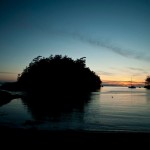 After taking night shifts listening to underwater hydrophones that are located throughout the islands we woke up the next morning knowing that they whales hadn’t passed our location. The day ended with news the whales were transients and going at a slower pace then expected. We were unable to see any whales that day, but our efforts continued nonetheless.
After taking night shifts listening to underwater hydrophones that are located throughout the islands we woke up the next morning knowing that they whales hadn’t passed our location. The day ended with news the whales were transients and going at a slower pace then expected. We were unable to see any whales that day, but our efforts continued nonetheless.
Another day we travelled an even farther distance south around Whidbey Island. Supposedly we were the first Beam Reach course to go this far south! We had heard that J pod was seen down in that area so we spent the day looking and found gray whales and a breaching Minke instead! This is very rare to see a Minke breach so our long trip down ended up being worth the time and fuel used.
I feel like I haven’t explained how exactly we go about finding the whales. I make it sound  as if we use underwater hydrophones as our main locating source, but this only half of our method! One part is to check to see if killer whale call spectrograms were picked up from the Lime Kiln underwater hydrophone if necessary, or listen to the hydrophones that stream live on orca sound at http://www.orcasound.net/ to see if we can locate the direction the whales are travelling. Our other main locating source is communicating with people. We keep in contact with land based observers, Vancouver, Victoria and San Juan Island whale watching boats, along with other companies such as the Whale Museum, the Whale Research Center, Sound Watch and Strait Watch. Each contacts purpose is either to educate boaters on vessel noise and how it can negatively impact whale communication, educate and entertain the public about their general biology or to continue research on the Southern Resident killer whale’s.  All of these contacts serve as vital source for our knowledge of the southern resident and transient killer whale location. In order for us to create an equal sharing of information relationship with these contacts we try and relay any information of what marine mammals we see on our daily routes. There are exceptions when there is the concern of overcrowding the whales, so we make it a point to be very careful about who we relay the information to.
For the past 4 weeks the information we have been able to provide for others is actually not about finding the Southern Resident killer whales.  When pulling out of Snug Harbor along the west side of San Juan Island on May 8th. Ally  spotted a humpback whale! Not only did we see a humpack whale but we caught them in a playful state allowing us to see the giant mammal breach multiple times! The amazing photo below was taken by our photographer/video-augrapher Carlos Sanchez.
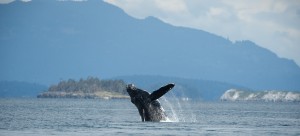
There was also pectoral and chin slapping that occurred. After our initial shock of observing a humpback breach not too far from our catamaran we called all of our contacts so that they could share in the enjoyment. That was the first moment we felt so good about giving information to our contacts instead of only receiving what they had to tell us.
We have also seen the Southern Resident killer whales for 5 days total so far, 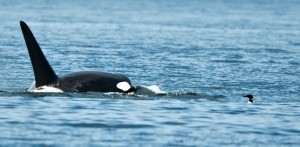 and it was all possible because of this connection with other whale observers and researchers!
and it was all possible because of this connection with other whale observers and researchers!
Read More
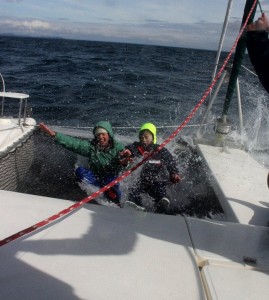
Photo by Val Veirs
I’m happy to say we all survived 3 weeks at sea with many stories to tell! To the left is one of my favorite pictures taken so far of me and Mandy riding the waves on the trampoline along the bow of the catamaran! And yes it was cold…as you can see in my face. Before I jump too far into the 3 weeks, I’ll start by reviewing how a typical day is structured. We first get up around 7:00 a.m. every day with specific tasks. We each rotate around 4 different roles that help keep the boat in shape and organize our science activities for the day.The systems reporter measures the water level in our tank, updates the sewage level,checks the percent of biodeisel left in the tank, and records our engine run time. The navigator is responsible for the weather forecast ,strength and direction of the currents,direction of the wind, amount of time predicted to reach our destination ,and is responsible for directing the boat accordingly throughout the day.The University of Washington developed a useful online program called BIS Portal and we also use another source called Open CPN that helps us predict the timing of the currents. If you live close to shore or are interested, take a look at what the tides might be like! Here is the link to BIS Portal: http://bis_portal.apl.washington.edu/bis_portal_app.php. We also learned how to use a current atlas called the Washburn Tables that seemed to conflict multiple times with Open CPN and Bis Portal predictions. This conflict further proves the complexity behind our ocean’s dynamics! Especially within the San Juan Islands where currents have hundreds of obstacles compared to deeper ocean waters away from the coast.
The science lead has the most work out of all the roles. This person is in charge of all the science activities and helps individuals reach their particular goals. The science reporter is the person who was science lead the day before and recaps what was achieved previously through graphs or a narrative presented in front of the crew. After a science meeting presenting each update, we cast off for the day.One topic that is always on our minds no matter what our science goals are for the day is the presence of whales! If we hear that whales are around we make finding them our number one priority!
We are also learning how to efficiently stay warm without putting on too many layers and making it impossible to move. Even though its Spring its very cold on the boat, especially at night in our cabins. I think this trip will make us all appreciate  how much is readily available to us on land on a daily basis (including a heater) and be more aware of how much energy and water we are using without thinking about it! This sustainability awareness is presented in the name of our catamaran. Our captain, Todd Shuster, named his catamaran the Gato Verde. 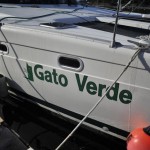 This translates to the Green Cat in spanish. It is “green” because it practices sustainable methods and “cat” represents the fact it is a catamaran. Our class revolves around practicing sustainability when we clean using environementally friendly cleaning materials and methods,minimize water usage, run the boat with biodiesel, and use the sails as our source of speed when wind is present. This class is already making me more conscious of my actions and keeping me more organized compared to how I used to be!
This translates to the Green Cat in spanish. It is “green” because it practices sustainable methods and “cat” represents the fact it is a catamaran. Our class revolves around practicing sustainability when we clean using environementally friendly cleaning materials and methods,minimize water usage, run the boat with biodiesel, and use the sails as our source of speed when wind is present. This class is already making me more conscious of my actions and keeping me more organized compared to how I used to be!
Read More
For the past two weeks our lectures on how people affect the marine ecosystem have changed my perspective on awareness of sustainability practices. Living in Bellingham, Washington for the past 5 years has opened my eyes to some sustainable practices such as ‘green building’ where homes and any other city building are built to be energy efficient. This efficiency is achieved by the use of solar heat instead of electric heat, and the design is made to control loss of air, heat, and moisture. Bellingham also offers organic food products at most of the grocery stores that come from nearby organic farms. Great practices such as organic delivery bins are encouraged where fresh organic fruits and vegetables from local organic farms are delivered right to your door. For people who usually rely on their car, the delivery bins allow it so no fuel is wasted and organic farms are supported. You can check out their mission at http://www.dandelionorganic.com/about.htm. It seems to me that their business should be mimicked by others in as many places as possible!
Recently we also had the opportunity to contribute to a 20 acre organic farm called Sweet Earth Farm on San Juan Island. Here is a picture of us removing the weeds that were suffocating the orchard! 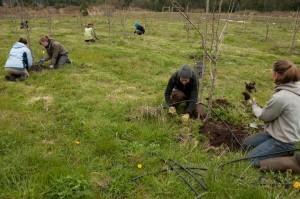 We learned about how they avoid using nonrenewable resources, chemicals and other artificial substances in order to efficiently grow their crops. It got even more interesting when the owner would tell us about other organic farmers that have made 100’s of people food from just a small acre of land using permaculture practices. Permaculture is a sustainable land use design that is based on natural ecology. This design uses what is available in nature in order to maximize the use of the land, minimize the work needed to maintain it, and restore the environment. At first I speculated whether or not this method could actually supply a large sum of people enough food for a few months. She made me more of a believer by sharing more stories of other farmers who have been successful in this field of agriculture. Supposedly in Paris a small plot of land using the permaculture design was able feed the whole city! How amazing is that? I can’t recall the name book that claimed this incredible story as true, but if you want proof I could go back and find out! This made me even more interested in her farm and way of living. It seemed so different from the norm and exactly the way farming should be. She also made her own ointments, lotions and tea from an herbal garden next to her house. All of these self sustainable practices definitely sparked my own thoughts about creating an organic garden that I could live off of and be comforted by the fact I would be contributing to instead of harming the environment.
We learned about how they avoid using nonrenewable resources, chemicals and other artificial substances in order to efficiently grow their crops. It got even more interesting when the owner would tell us about other organic farmers that have made 100’s of people food from just a small acre of land using permaculture practices. Permaculture is a sustainable land use design that is based on natural ecology. This design uses what is available in nature in order to maximize the use of the land, minimize the work needed to maintain it, and restore the environment. At first I speculated whether or not this method could actually supply a large sum of people enough food for a few months. She made me more of a believer by sharing more stories of other farmers who have been successful in this field of agriculture. Supposedly in Paris a small plot of land using the permaculture design was able feed the whole city! How amazing is that? I can’t recall the name book that claimed this incredible story as true, but if you want proof I could go back and find out! This made me even more interested in her farm and way of living. It seemed so different from the norm and exactly the way farming should be. She also made her own ointments, lotions and tea from an herbal garden next to her house. All of these self sustainable practices definitely sparked my own thoughts about creating an organic garden that I could live off of and be comforted by the fact I would be contributing to instead of harming the environment.
Our last lecture before voyaging out to sea on the catamaran was presented by Val Veirs and David Bain on the effects of cars on killer whales. Who knew that there is actually a strong link between the two? One of the reasons cars harm the whales is by the construction of roads. Roads typically are built to get people from one place to another, without thinking of what could be destructive to the surrounding marine life. How exactly do roads harm surrounding marine waters? Roadways that are built around streams create a larger impervious service. This service includes cement parking lots, crowded neighborhoods and anything that will decrease the soil band around streams. This soil is vital to the health of  streams because it is needed to filter the incoming water from these impervious services that sometimes contain waste, chemicals, and/or fossil fuels that leak from cars. The San Juan Islands in particular are known to have a very thin layer of soil, creating an inefficient filter system on the land. This filter system is important for the health of marine animals because anything that filters into the stream is brought to the ocean, where it is consumed by the fish that are eaten by the whales. People tend ignore the fact we live around a complex marine ecosystem that is sensitive to changes.  Another reason cars are harmful to killer whales is by the construction of low bridges that are built in places where the orcas typically travel through. An example of this situation was when the Hood Canal bridge was reopened in 2009.  It just so happens that around the time it was reopened the orcas started avoiding this passage. There aren’t many cases where bridges have this effect on the whales, but there are many accounts of fossil fuels contaminating marine waters. It is apparent that people need to raise awareness on the harmful effects of fossil fuels on the marine ecosystem so that alternative fuel options can be popularized!
Read More
Ok so it’s only been a week but a lot has happened so far! First we ventured to the most popular whale watching park on San Juan Island known as Lime Kiln State Park. Over 100,000 people gather at this park in the summer months to observe the Southern Resident killer whales that come right up next to the shore line! Supposedly they like to play in the kelp and corral salmon against the rocky shore. The lighthouse serves as a research station recording killer whale calls from a hydrophone in the water a couple meters from shore. I was  discussing my initial curiosities and questions about the whales in the lighthouse when I spotted a tall dorsal fin followed by a spurt of air from the water! Supposedly my eyes widened and jaw dropped. Immediately we ran outside with our cameras to see if what I thought I saw through the small section of the window in the lighthouse was true. At first I was worried that I was just seeing things and people wouldn’t believe me from that day on if I ever saw anything exciting, but about 4 minutes later we saw 3 transient killer whales heading north around San Juan Island! Supposedly this is a 1 in 1000 chance!  These type of whales feed primarily on marine mammals and are rarely seen this far south especially this time of the year! Am I a whale whisperer? Only time will tell…
Transients heading north from Lime Kiln State Park

Continuing on in the week, no more whales were seen but we learned heaps of background information relevant to our research. After only 4 days of lectures I can confidently say I have acquired knowledge behind pretty much all aspects of the Salish Sea and Washington state. Here are some the main topics we covered:
Physics of Sound
Lecture presented by Val Veirs; PhD in Physics from Illinois Institute of Technology

Bathymetry, Oceanographic and Geologic Background of the Salish Sea and Washington State
Lecture was presented by Scott Veirs; PhD in Oceanography from University of Washington
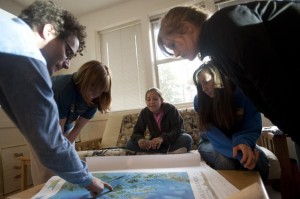
Ecological Perspectives on the Southern Resident killer whales
Lecture by Robin Kodner; PhD in Biology from Harvard University
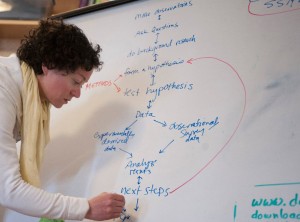
After being here for only a week it is apparent that the San Juan Islands are a tight knit community full of passionate people dedicating their lives to these killer whales. They don’t only refer to individuals within pods as J1 or K8 but have chosen names such as Capuccino, Blackberry, and Doublestuf that allow any individual to feel more connected to the whales. What I am most fascinated by is the Indian art that floods the island. This art seems to illustrate the underlying history of the mystery behind these whales. At our instructor Val Veirs’ house there was one peice of Indian art that particularly caught my eye.
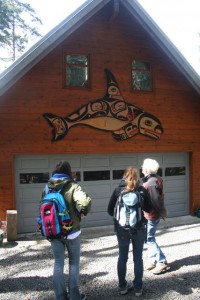
It was a huge wood carving of a killer whale overlain with a beautiful painting. I’ve been intrigued by native designs and woodwork especially of salmon and killer whales since I was little, so naturally I was curious to know the story behind it.This Tlingit story focuses on the boy in the dorsal fin of the painting and how he endures an adventure that eventually leads him to seek revenge on his two brothers in law. The boy does this by creating the killer whale from a wood carving and bringing the whale to life by throwing it in the water. Once the killer whale kills his two brothers in law in revenge, the whale asks if there is anything else he can do for the boy. The boy asks for one more favor. He asks the whale to never harm a human being ever again. This establishment represents the peaceful relationship between humans and these killer whales. People in the past have referred to these whales as “Devils of the Sea” but there has actually never been an instance where a killer whale in the wild has ever harmed a human being. The artist responsible for this artwork is named Odin Lonning. You can check out his beautiful artwork at http://www.odinlonning.com/.
Overall this trip has been quite the adventure so far but there are many more to come! In the next few blogs I will mention my classmates more often so you get to know them as well! The picture below is of us four girls about to go sea kayaking. In order from left to right is Ally, Mandy, me then Emalie. Updates will be available in the next few weeks!
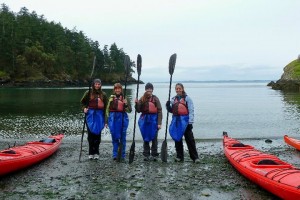
Read More
 The Southern Residents are known to primarily eat chinook salmon. Chinook salmon eat forage fish. The forage fish eat zooplankton and the zooplankton eat phytoplankton. These interactions led to my hypothesis trying to find a linear relationship between primary productive ‘hotspots’ or areas of high amount of phytoplankton and presence of fish. My sample sites were on the west side of San Juan Island and over Salmon Bank. I concluded my project and presentation with insignificant differences between phytoplankton abundance between sites and the absence of large targets. This does not mean that there isn’t a linear relationship between the two. It implies that environmental factors that can drive variation in phytoplankton abundance within our transect of study was insignificantly different between sites. Therefore future methods were suggested to contain another transect with different tidal patterns so  primary productive hotspots or significant differences in abundance of phytoplankton could be found. If anyone wants to look at each of our presentations you can go to the beam reach website at http://www.beamreach.org/class/2011-spring and our talks should be up there soon! Well this is it…have a great summer everyone!
The Southern Residents are known to primarily eat chinook salmon. Chinook salmon eat forage fish. The forage fish eat zooplankton and the zooplankton eat phytoplankton. These interactions led to my hypothesis trying to find a linear relationship between primary productive ‘hotspots’ or areas of high amount of phytoplankton and presence of fish. My sample sites were on the west side of San Juan Island and over Salmon Bank. I concluded my project and presentation with insignificant differences between phytoplankton abundance between sites and the absence of large targets. This does not mean that there isn’t a linear relationship between the two. It implies that environmental factors that can drive variation in phytoplankton abundance within our transect of study was insignificantly different between sites. Therefore future methods were suggested to contain another transect with different tidal patterns so  primary productive hotspots or significant differences in abundance of phytoplankton could be found. If anyone wants to look at each of our presentations you can go to the beam reach website at http://www.beamreach.org/class/2011-spring and our talks should be up there soon! Well this is it…have a great summer everyone!














 Twitter
Twitter LinkedIn
LinkedIn Facebook
Facebook